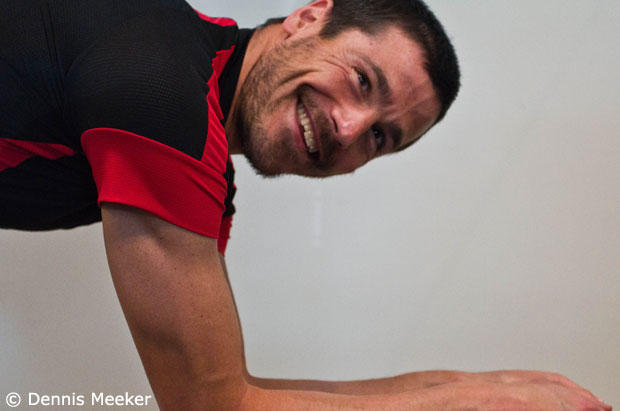It had been a few years since I had worked with Andy on his bike position. Over time, his bike setup had diverged from our initial work together. Why? Andy has probably had 10 different bikes since the last time I’d seen him. Attention to detail is a must when replicating positions. It may seem simple, but a few millimeters here and there over 10 bikes can end up creating substantial differences from the original fit coordinates.
Here is Andy Potts in action at the Ironman World Championships in Kona, Hawaii.

Andy's first visit with me at Superfly Cycles / Colorado Multisport in Boulder, CO was this winter. This is the only photo that I found that gave a decent visual of his before position.

Andy “races” 170mm cranks. Note that I said “races”...because last year, Andy would train on 175mm cranks and then switch to 170s for race day, but failed to make any adjustments to the bike in order to account for the difference in crank length. He is now sticking to 170mm cranks for both training and racing.

I’ve gradually raised Andy’s saddle over the past few months. At first, he could feel the change and it felt awkward and that’s where I’d stop. There are two types of changes in my opinion. Those that feel good right away, and those that are right, but the athlete needs time for them to take. This last visit, the saddle height change felt good right away, so I was confident making the change during the season. I've now taken 5 degrees out of Andy’s knee extension.

Andy’s back angle had also come up over the years. A change to his front end is the major culprit here. Andy used to ride the Pro Missile bar which basically has zero stack height as the pads mount directly onto the base bar. He then switched to the Pro Missile EVO bars that have significantly more stack height.

To counter this, we removed all spacers and actually moved Andy down a bike frame size from a 57.5 to a 55. Was it necessary? I’d say, with his current aerobar selection/obligation, Yes, it’s a good change. There actually isn’t a big difference between the two sizes ~6mm lower, which is almost a degree of back angle.

Placing markers on Andy's upper body. To talk numbers, Andy's back angle was 25 degrees (measured with the retul motion capture system) when he came in this winter (greater trochantor-acromium-horizon). He's now down to 19-20 degrees depending on his posture. Something to note - his hip angle did not change.

I slid Andy's arm pad back 15mm in order to improve where he contacts and supports himself on the pad. He was running it more toward the back half of his forearm. I don't mind being able to get to this sort of position where an athlete torques to accelerate. However, I don't want this to be an athlete's go to position.

Andy’s not afraid to get his hands dirty. The very adjustable Pro Missile EVO bar is not easily adjusted, so an extra set of hands made this easy.

You’ll notice in the photos that by changing Andy’s posture, he now rotates forward at the pelvis and his upper body rests nicely on the front end. This was achieved by lowering the front end, which if you’re using the correct saddle, should promote anterior pelvic rotation.

I’m always harping about posture on the bike, I think it is very important part of fit and although as fitters we are moving contact points around, the way an athlete touches/supports on those points is key.

Because a person like Andy prefers to ride forward, I need to ensure that his upper body is supported on the front end properly. Make no bones about it, riding in this position places more weight on the front end compared to a less forward and low position. Once setup properly, it will take some time to adapt to supporting yourself on the front, but it is adaptable.

These low, forward positions are in my opinion the way a TT bike should be ridden. Obviously, one’s morphology is the determinant of how far you can take it. The hips should mimic what the shoulders are doing in order to preserve an optimal hip angle range. For example, I don’t want to have an athlete’s saddle as far forward as it will go when the front end isn’t adjusted to compliment the “steepness”. This also goes the other way...I don’t want to have a saddle or an athlete riding with a very rearward position with a very low front end, closing off the hip angle.

Using power to simulate intensity levels that he'll produce during racing. He will still need to get out on the road and ride, but since Andy rides that trainer often, he has a good perception of how something will feel on the road via riding on the turbo.

Andy sporting a bit of beard growth...must be deep in training.

Communication is key in a bike fit. You don't just put someone into a position and send them on their way. It’s a process where you guide an athlete towards a particular position, but where they have options, that are neither right nor wrong.

Visual feedback is an important tool show and talk about an athlete's position.

Website: 51-SPEEDSHOP.com
twitter: @matsteinmetz


